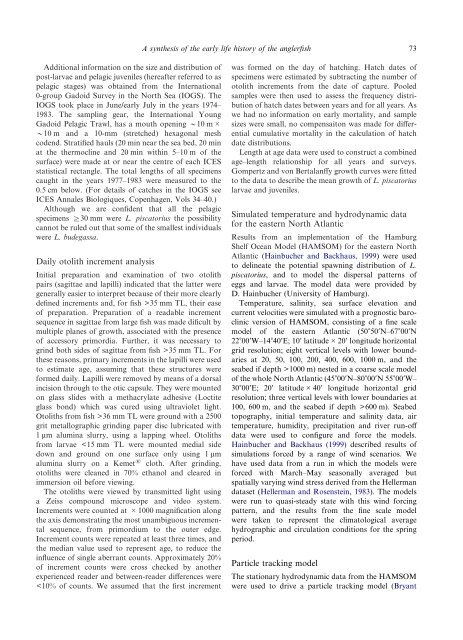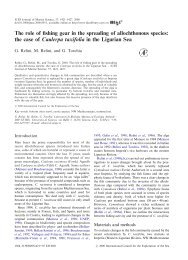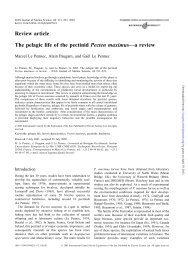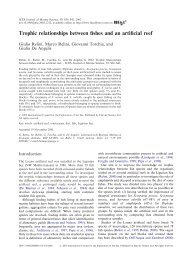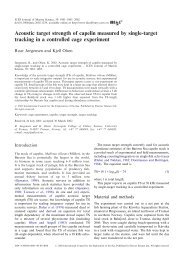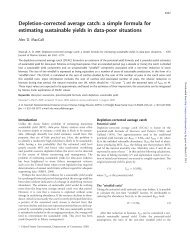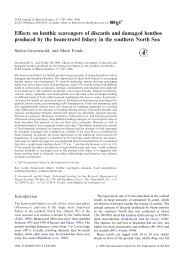A synthesis of the early life history of the anglerfish, Lophius ...
A synthesis of the early life history of the anglerfish, Lophius ...
A synthesis of the early life history of the anglerfish, Lophius ...
Create successful ePaper yourself
Turn your PDF publications into a flip-book with our unique Google optimized e-Paper software.
A <strong>syn<strong>the</strong>sis</strong> <strong>of</strong> <strong>the</strong> <strong>early</strong> <strong>life</strong> <strong>history</strong> <strong>of</strong> <strong>the</strong> <strong>anglerfish</strong><br />
73<br />
Additional information on <strong>the</strong> size and distribution <strong>of</strong><br />
post-larvae and pelagic juveniles (hereafter referred to as<br />
pelagic stages) was obtained from <strong>the</strong> International<br />
0-group Gadoid Survey in <strong>the</strong> North Sea (IOGS). The<br />
IOGS took place in June/<strong>early</strong> July in <strong>the</strong> years 1974–<br />
1983. The sampling gear, <strong>the</strong> International Young<br />
Gadoid Pelagic Trawl, has a mouth opening 10 m<br />
10 m and a 10-mm (stretched) hexagonal mesh<br />
codend. Stratified hauls (20 min near <strong>the</strong> sea bed, 20 min<br />
at <strong>the</strong> <strong>the</strong>rmocline and 20 min within 5–10 m <strong>of</strong> <strong>the</strong><br />
surface) were made at or near <strong>the</strong> centre <strong>of</strong> each ICES<br />
statistical rectangle. The total lengths <strong>of</strong> all specimens<br />
caught in <strong>the</strong> years 1977–1983 were measured to <strong>the</strong><br />
0.5 cm below. (For details <strong>of</strong> catches in <strong>the</strong> IOGS see<br />
ICES Annales Biologiques, Copenhagen, Vols 34–40.)<br />
Although we are confident that all <strong>the</strong> pelagic<br />
specimens 30 mm were L. piscatorius <strong>the</strong> possibility<br />
cannot be ruled out that some <strong>of</strong> <strong>the</strong> smallest individuals<br />
were L. budegassa.<br />
Daily otolith increment analysis<br />
Initial preparation and examination <strong>of</strong> two otolith<br />
pairs (sagittae and lapilli) indicated that <strong>the</strong> latter were<br />
generally easier to interpret because <strong>of</strong> <strong>the</strong>ir more cl<strong>early</strong><br />
defined increments and, for fish >35 mm TL, <strong>the</strong>ir ease<br />
<strong>of</strong> preparation. Preparation <strong>of</strong> a readable increment<br />
sequence in sagittae from large fish was made dificult by<br />
multiple planes <strong>of</strong> growth, associated with <strong>the</strong> presence<br />
<strong>of</strong> accessory primordia. Fur<strong>the</strong>r, it was necessary to<br />
grind both sides <strong>of</strong> sagittae from fish >35 mm TL. For<br />
<strong>the</strong>se reasons, primary increments in <strong>the</strong> lapilli were used<br />
to estimate age, assuming that <strong>the</strong>se structures were<br />
formed daily. Lapilli were removed by means <strong>of</strong> a dorsal<br />
incision through to <strong>the</strong> otic capsule. They were mounted<br />
on glass slides with a methacrylate adhesive (Loctite<br />
glass bond) which was cured using ultraviolet light.<br />
Otoliths from fish >36 mm TL were ground with a 2500<br />
grit metallographic grinding paper disc lubricated with<br />
1 μm alumina slurry, using a lapping wheel. Otoliths<br />
from larvae 600 m). Seabed<br />
topography, initial temperature and salinity data, air<br />
temperature, humidity, precipitation and river run-<strong>of</strong>f<br />
data were used to configure and force <strong>the</strong> models.<br />
Hainbucher and Backhaus (1999) described results <strong>of</strong><br />
simulations forced by a range <strong>of</strong> wind scenarios. We<br />
have used data from a run in which <strong>the</strong> models were<br />
forced with March–May seasonally averaged but<br />
spatially varying wind stress derived from <strong>the</strong> Hellerman<br />
dataset (Hellerman and Rosenstein, 1983). The models<br />
were run to quasi-steady state with this wind forcing<br />
pattern, and <strong>the</strong> results from <strong>the</strong> fine scale model<br />
were taken to represent <strong>the</strong> climatological average<br />
hydrographic and circulation conditions for <strong>the</strong> spring<br />
period.<br />
Particle tracking model<br />
The stationary hydrodynamic data from <strong>the</strong> HAMSOM<br />
were used to drive a particle tracking model (Bryant


